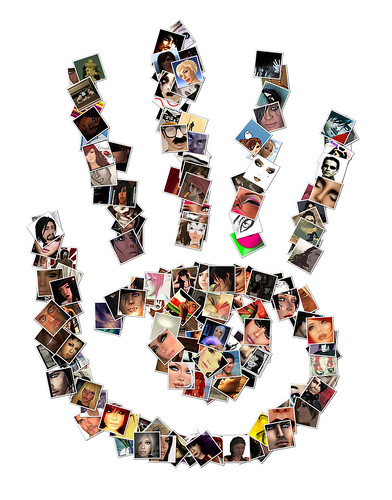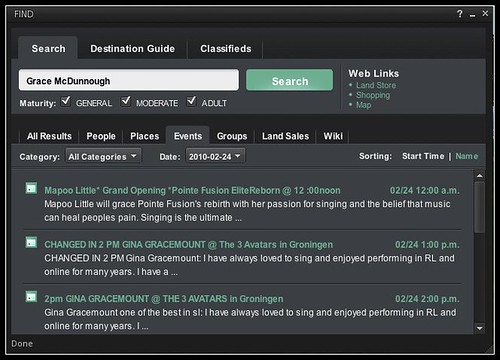cc image courtesy flickr.com/photos/amibeattie
Chun-Yuen Teng and Lada A. Adamic from the School of Information at the University of Michigan have just published some interesting research on user retention in the virtual world Second Life ®.
The researchers observed that a high percentage (95.4%) of users who had made some financial investment in SL were likely to remain. From there, they set out to determine which factors were the best predictors of retention. The findings are quite interesting and I'll summarize, but please read the detailed report for the analysis.
Linden Lab provided the research team a dataset on user activity including snapshots of the social network, group affiliations, as well as summary interaction data such as first and most recent login, user-to-user transactions and pairwise chat frequencies. The researchers focused on the slice of data spanning May-June 2009 and evaluated four different facets of the user experience: usage (time spent), networking (number of contacts, groups and social cohesion), interactions (frequency and regularity), and financial transactions (selling and buying).
1) On Usage
The total length of time spent in SL was not a significant predictor, however the intensity (total time spent in world) was a strong predictor.
2) On Networking
While all parameters of networking (# friends, # active friends, % active friends, clustering, # groups, group overlaps) were highly correlated with retention, the number of raw contacts and groups, were key to identifying which users stay. The diversity of those contacts was a positive predictor but not a strong correlation.
3) On Interactions
For this I will quote directly from the report:
We observe that almost all chat parameters are more predictive that the static network measures above. Furthermore, one need not resort to complex metrics because the best predictions are also the simplest, e.g. the number of chat partners (not necessarily friends), or the number of days on which the user chatted.In other words, talking with people matters.
4) On Financial Transactions
Here, the researchers looked at data on purchases, sales, and transfer of goods as well as proximity within the social graph. The results indicated that while economic activity was correlated with retention, it was less so than chat. Spending money was more highly correlated than making money. Having a high proportion of free transactions was highly predictive. Profits did not improve the predictions of whether a user would stay. The amount of money paid to Linden Lab versus other users was only weakly predictive.
Strong and Weak Ties
One thing intriguing about the UM findings is that "simple variables are just as predictive as more complex ones. And among those simple predictors, by far it is interaction with others, whether friends or strangers that correlated more with long user life." This is promising, and far away from the complexity of trying to predict new user world views.
This is also the point the live music community was trying to drive home with Colossus Linden at last year's SLCC. I wrote about it in my post "Second Life, Meet the Social Web". From an informal survey of the live performance community, our results echoed the UM research.
Here's what we found:
In 2007 and still in 2009 the primary concerns were related to connecting with people and communicating. In SL-specific terms, our then and current hurdles are precisely the same. From this year's survey data, the top three issues: group communications, the limit of 25 groups per account, and the event system itself are the self-same issues that were raised and discussed fervently in 2007 and hence.
Most interesting, those things that might actually increase income and profitability for performers and venue owners - increased agent limit and XStreet sales - were ranked forth and fifth by a 20% margin. (ref see slides 11-13) It's probably a good thing that XStreet sales are the lowest priority because on the sale of real world goods such as CDs or even branded t-shirts and the like, Colossus replied: "I can't say that's on the roadmap at the moment." For the immediate future, there will be no sale of real world goods.
The crux of the conversation we wanted to have with Linden Lab was to highlight that the "killer app" of Second Life is connecting people - to other people, ideas, events, experiences - all that makes Second Life what is has become. These issues are not unique to live performance, they are the very essence of the world itself. We live parts of our lives online, we have relationships that cross the artificial boundaries of physical space and time.Searching for People
How do you find people to talk to in Second Life? You could join a group and try to meet and chat with people that way but groups in Second Life have their own set of challenges.
I usually start by looking for things to do, but today the means to find events in Viewer 2.0 is still badly broken in my opinion. It's hard to describe just how bad the results are broken, because it's hard to even know how to find an event. As far as I can tell (I'm no Viewer 2.0 expert) this is still the process:
1. Find SEARCH. Hint: the search box is still in the top right or you can open it via ctrl-F. Notice you won't see "Events" there, so just keep following along.
2. Now SEARCH.
What kind of search should you do? Well, what are you looking to find? If you're new, you don't know what to look for yet so for the future, just type in "Grace McDunnough".
3. Find the EVENTS tab.
The search results pane should have opened when you searched for Grace and now just select the Events tab.
4. From here you'll just have to be adventurous. There's really no way to navigate the Events listing in this viewer release, so unless you got really lucky you are probably hearing Bono sing in your ear.
This still feels very clumsy to me, so much so that I've stayed on the old viewer because so much of my SL activity is tied to finding things to do.
I hoped this might be sorted out in Viewer 2.1 but the recent Second Life blog post "A Step Forward for Second Life Search" indicates that we will have to wait a bit longer for events to be sorted out.
After launching Viewer 2, we found that events posted with deliberately inappropriate keywords were causing problems. This kind of "gaming" caused some events to dominate search results. This is why events were removed from the All tab. We'll be looking at how to best address event listings without causing search results to be unfairly skewed. For now, events can be found in the Events tab.But not everyone knows about or wants to attend events, so even though this is an obvious problem, there's there's still the question about connecting people.
Chun-Yuen and Lada conclude their paper with a recommendation to "further explore the mechanisms by which users might influence each others' continued participation". When I read that, the first thing that occurred to me was the "Second Life is deserted" media meme. It does feel deserted if you never run into other people, and according to the research you are less likely to stick around.
One might try to design for more non-serendipitous meetings, along the lines that Richard Bartle describes, by allowing user paths to cross more often. I don't really know how you could do that successfully in SL, given the social norms and built-in expectations.
While it may always be hard to overcome the "Second Life is deserted" meme simply because of the vastness of the world, a goal of developing simple communication and connections between people - strong ties and weak ties - should be a step in the right direction.
Share Some Grace:

